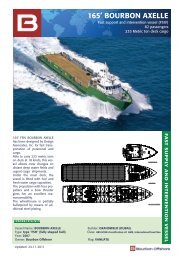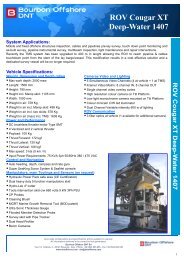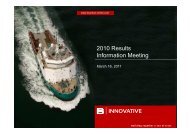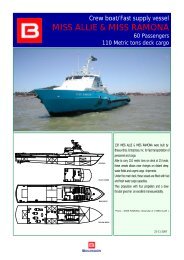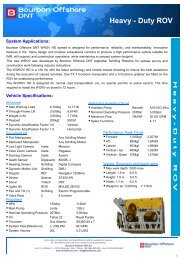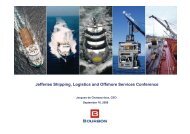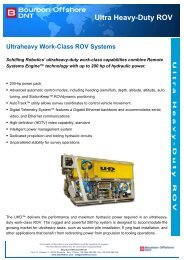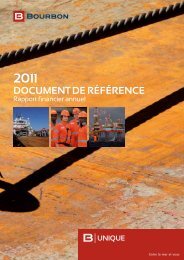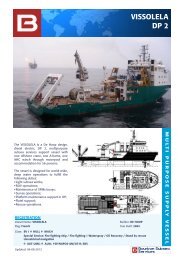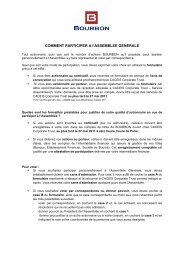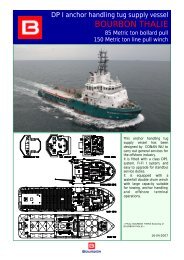4NotesCONSOLIDATED FINANCIAL STATEMENTSto the consolidated financial statementsthe proportion of shareholders’ equity held. The assessment mayalso take into consideration the following parameters, to the extentthat they can be reliably measured:3 potential unrealized gains, particularly property gains;3 prospects for profi tability.Impairment of financial assetsOn each closing date, the Group assesses whether a fi nancial assetor a group of fi nancial assets is impaired.Assets carried at amortized costsIf there is objective evidence that an impairment loss on loansand receivables carried at amortized cost has been incurred, theamount of loss is measured as the difference between the asset’scarrying amount and the present value of estimated future cashfl ows (excluding future credit losses that have not been incurred),discounted at the fi nancial asset’s original effective interest rate(i.e. the effective interest rate computed at initial recognition). Thecarrying amount of the asset shall be reduced through the use of anallowance account. The amount of loss shall be recognized in profi tor loss.The Group fi rst assesses whether objective evidence of impairmentexists on an individual basis for individually signifi cant fi nancialassets, and then, on an individual or collective base, for fi nancialassets which are not individually signifi cant. If it determines thatthere is no objective evidence of depreciation for a fi nancial assetconsidered individually, in a signifi cant or non-signifi cant amount,this asset is included in a group of fi nancial assets presenting similarcredit risk characteristics, and this group of fi nancial assets is subjectto a collective impairment test. Assets subject to an individualimpairment test, for which impairment is recognized or continues tobe recognized, are not included in a collective impairment test.If the amount of the impairment decreases during a subsequent year,and if this decrease can be objectively tied to an event that occurredafter recognition of the impairment, the impairment previouslyrecognized is reversed. A reversal of impairment is booked asincome/loss provided the book value of the asset does not becomegreater than the amortized cost on the date the impairment isreversed.For trade receivables, impairment is recognized when there is anobjective indication (such as a probability of bankruptcy or signifi cantfi nancial diffi culties for the debtor) that the Group will be unableto recover the amounts owed under the contractual terms of theinvoice. The book value of the trade receivable is reduced using avaluation allowance account. Impaired outstanding amounts arerecognized as a loss when they are deemed unrecoverable.Available-for-sale financial assetsIf an available-for-sale asset is impaired, an amount calculated asthe difference between its acquisition cost (net of any repaymentof principal and any depreciation) and its current fair value, less anyimpairment previously booked as income/loss, is transferred fromshareholders’ equity to income. Impairment on equity instrumentsmay not result in a reversal booked as income. Impairment on debtinstruments is reversed as income if the increase in the fair value ofthe instrument may be objectively related to an event that occurredafter recognizing the impairment in the income statement.1.5.9 Inventories and work in progressInventories are measured at the weighted-average cost method forraw materials and at the production cost for work in progress andfi nished goods.When the production cost of fi nished goods is greater than theselling price at the inventory date, impairment is recognized in orderto reduce the value of the inventories to their net realizable value.1.5.10 Cash and cash equivalentsCash and cash equivalents consist of cash on hand and in banks,short-term deposits and marketable securities. Cash and cashequivalents are recorded at fair value.1.5.11 Non-current assets held for sale anddiscontinued operationsNon-current assets held for salePursuant to IFRS 5, non-current assets (or disposal groups) andthe related liabilities are classifi ed as “held for sale” if their carryingamount will be recovered primarily through a sale transaction ratherthan continuing use. This classifi cation implies that the assets (ordisposal groups) intended for sale are available for immediate sale, intheir present condition, and that the sale is highly probable.The high probability of the sale is assessed on the basis of thefollowing criteria: management has initiated an asset (or disposalgroup) disposal plan and a program to fi nd a buyer and fi nalize theplan has been launched. In addition, the assets must be activelymarketed for sale at a reasonable price in relation to their fair value.The sale of the assets (or disposal group) is assumed to take placewithin one year from the date of being classifi ed as assets held forsale.Non-current assets (or disposal groups) intended to be sold andclassifi ed as held for sale are measured at the lower of their previouscarrying amount and fair value less costs to sell. They are no longerdepreciated as of the date they are classifi ed as assets held for sale.Discontinued operationsA discontinued operation is an activity or a signifi cant geographicregion for the Group which is either being sold or classifi ed as anasset held for sale. The items of the income statement and the cashfl ow statement for these discontinued operations or operationsbeing sold are presented on specifi c lines of the fi nancial statementsfor all periods presented. As a result, certain elements of the incomestatement and the cash fl ow statement for the previous year arerestated in order to present comparative information for thesediscontinued operations.74BOURBON - 2011 Registration Document
CONSOLIDATED FINANCIAL STATEMENTS4Notes to the consolidated financial statements1.5.12 Treasury sharesWhen the Group purchases its own equity instruments (treasuryshares), they are deducted from shareholders’ equity. No profi t orloss is booked in the income statement at the time of the purchase,sale, issue or cancellation of the Group’s equity instruments.1.5.13 ProvisionsProvisions are recognized when the Group has a present obligationresulting from a past event, when it is probable that an outfl ow ofresources embodying economic benefi ts will be necessary to settlethe obligation, and when the amount of the obligation can be reliablyestimated.If the effect of the time value of the money is signifi cant, the provisionsare discounted on the basis of a pre-tax rate which refl ects the risksspecifi c to the liability, if any. When the provision is discounted, theincrease in the provision related to the passage of time is recognizedas a fi nance expense.1.5.14 Employee benefitsEmployee benefi ts include retirement indemnities, seniority awards,incentives and profi t-sharing.Retirement benefit obligationsGroup employees receive retirement indemnity in addition to thelegal retirement benefi ts in effect in the countries in which they areemployed.Pursuant to IAS 19 “Employee benefi ts”, retirement benefi t obligationsare measured using the projected unit credit method. Under thismethod, the valuation of the commitment takes into considerationthe pension rights that the employee will have acquired on the date ofhis retirement. However, the commitment is allocated proportionatelybetween the employee’s seniority on the calculation date, taking intoaccount the ratio between the employee’s current seniority and hisseniority projected at retirement date.These calculations include the following assumptions:3 retirement age: legal age prevailing in each country;3 average life expectancy: based on the mortality table applicableto each country;3 discount rate;3 infl ation rate;3 turn-over: established for each company, using the average turnoverobserved over the last fi ve years;3 assumptions on salary increases;3 calculation of the rights based on collective agreements orspecifi c agreements in force in each entity/country.In accordance with the option offered by IAS 19, the Group haselected to account for its actuarial differences directly in shareholders’equity.IncentivesIncentives are based on the Company’s performance, measuredprimarily by the increase in revenues and operating margins.There are two application methods: the fi rst consists of applying thecoeffi cient of increase for each individual to the salary he receivedduring the last six months, with the bonus paid every six months.The second method, calculated annually, incorporates a progressivebonus by salary category. The amount of the bonus is, therefore,calculated by applying the corresponding percentage to the annualpayroll. One part is then distributed uniformly among the employeesand the other one is distributed in proportion to the gross salaries forthe reference year.Where the bonus is deposited to the Company Savings Plan (Pland’Epargne Entreprise – PEE), an employer’s contribution of 20% isgranted.Profit sharingThe amounts owed under profi t sharing are either paid directly to theemployee if he so requests, or locked in for fi ve years with a rightscustodian (barring early release).Stock option plansThe cost of equity-settled share-based payment transactions withemployees, granted after November 7, 2002, is measured at the fairvalue of the equity instruments granted at the grant date using the“Black & Scholes” method.This cost is recognized as personnel expenses as a contra entry toan equivalent increase in shareholders’ equity, using the straight-linemethod over the vesting period. This period ends on the date onwhich the employees obtain an unconditional right to the instruments(“the rights acquisition date”).The cumulative expense recorded for these transactions at the endof each year until the rights acquisition date takes into accountthe Group’s best estimate, on that date, of the number of equityinstruments that will be acquired.When stock subscription options are exercised by their benefi ciaries,the shares issued on that occasion will be remitted to them. Theexercise price of the shares will be recognized as cash by thecounterparty of the shareholders’ equity. In the case of stockpurchase options, income from the sale at the time the options areexercised will be recognized as shareholders’ equity.Bonus sharesThe cost of equity-settled share-based payment transactions withemployees, granted after November 7, 2002, is measured at the fairvalue of the equity instruments granted at the grant date.This cost is recognized as personnel expenses as a contra entry toan equivalent increase in shareholders’ equity, using the straight-linemethod over the vesting period. This period ends on the date onwhich the employees obtain an unconditional right to the instruments(“the rights acquisition date”).BOURBON - 2011 Registration Document 75



